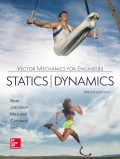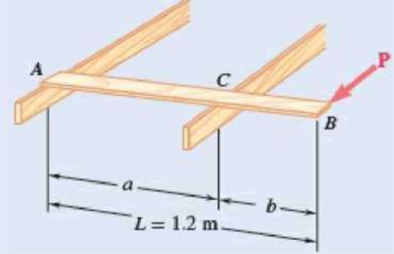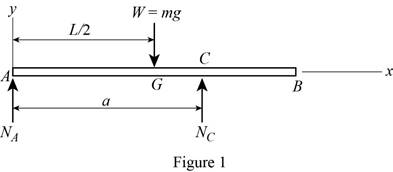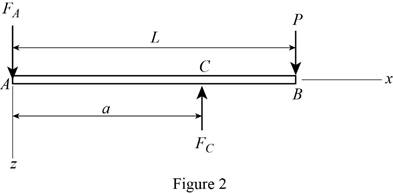
A 1.2-m plank with a mass of 3 kg rests on two joists. Knowing that the coefficient of static friction between the plank and the joists is 0.30, determine the magnitude of the horizontal force required to move the plank when (a) a = 750 mm, (b) a = 900 mm.

Fig. P8.37
(a)
Find the magnitude of the horizontal force required to move the plank.
Answer to Problem 8.37P
The magnitude of the horizontal force required to move the plank is
Explanation of Solution
Given information:
The length of the plank is
The mass of each plank is
The coefficient of static friction between the plank and the joists is
The distance between the points A and C in the plank is
Calculation:
Find the friction force (F) using the relation.
Show the free-body diagram of the member AB is vertical plane as in Figure 1.

Take moment about point A.
Resolve the vertical component of forces.
Show the free-body diagram of the member AB is horizontal plane as in Figure 2.

Take moment about point A.
Resolve the vertical component of forces.
Find the weight of the plank (W) using the relation.
Here, the acceleration due to gravity is g.
Consider the acceleration due to gravity is
Substitute 3 kg for m and
Substitute 29.43 N for W, 1.2 m for L, and 750 mm for a in Equation (1).
Substitute 29.43 N for W, 1.2 m for L, and 750 mm for a in Equation (2).
Substitute 1.2 m for L, and 750 mm for a in Equation (3).
Substitute 1.2 m for L, and 750 mm for a in Equation (4).
At point A, the plank to slip;
Find the horizontal force P using the relation.
Substitute 0.6P for
At point C, the plank to slip;
Find the horizontal force P using the relation.
Substitute 1.6P for
The smallest value of P will slip the plank. The plank will slip at A.
Therefore, the magnitude of the horizontal force required is
(b)
Find the magnitude of the horizontal force required to move the plank.
Answer to Problem 8.37P
The magnitude of the horizontal force required is
Explanation of Solution
Given information:
The length of the plank is
The mass of each plank is
The coefficient of static friction between the plank and the joists is
The distance between the points A and C in the plank is
Calculation:
Refer part (a) for calculation.
Substitute 29.43 N for W, 1.2 m for L, and 900 mm for a in Equation (1).
Substitute 29.43 N for W, 1.2 m for L, and 900 mm for a in Equation (2).
Substitute 1.2 m for L, and 900 mm for a in Equation (3).
Substitute 1.2 m for L, and 900 mm for a in Equation (4).
At point A, the plank to slip;
Find the horizontal force P using the relation.
Substitute 0.3333P for
At point C, the plank to slip;
Find the horizontal force P using the relation.
Substitute 1.3333P for
The smallest value of P will slip the plank. The plank will slip at C.
Therefore, the magnitude of the horizontal force required is
Want to see more full solutions like this?
Chapter 8 Solutions
Vector Mechanics for Engineers: Statics and Dynamics
- The airplane weighs 144100 lbs and flies at constant speed and trajectory given by 0 on the figure. The plane experiences a drag force of 73620 lbs. 0 a.) If 11.3°, determine the thrust and lift forces = required to maintain this speed and trajectory. b.) Next consider the case where is unknown, but it is known that the lift force is equal to 7.8 times the quantity (Fthrust Fdrag). Compute the resulting trajectory angle and the lift force in this case. Use the same values for the weight and drag forces as you used for part a. 20. YAAY' Farag Ө Fthrust CC + BY NC SA 2013 Michael Swanbom Flift Fweight The lift force acts in the y' direction. The weight acts in the negative y direction. The thrust and drag forces act in the positive and negative x' directions respectively. Part (a) The thrust force is equal to 101,855 ☑ lbs. The lift force is equal to 141,282 ☑ lbs. Part (b) The trajectory angle 0 is equal to 7.31 ✓ deg. The lift force is equal to 143,005 ☑ lbs.arrow_forwardsimply supported beam has a concentrated moment M, applied at the left support and a concentrated force F applied at the free end of the overhang on the right. Using superposition, determine the deflection equations in regions AB and BC.arrow_forwardwhat is heat exchanger, what are formulas, and their importance, define the diagram, and give me a script on how to explain the design of heat exchanger, and how did values end up in that number. based on standards . what is dshellarrow_forward
- FIGURE P1.37 1.38 WP As shown in Figure P1.38, an inclined manometer is used to measure the pressure of the gas within the reservoir, (a) Using data on the figure, determine the gas pressure, in lbf/in.² (b) Express the pressure as a gage or a vacuum pressure, as appropriate, in lbf/in.² (c) What advantage does an inclined manometer have over the U-tube manometer shown in Figure 1.7? Patm = 14.7 lbf/in.² L I C i Gas a Oil (p = 54.2 lb/ft³) 140° 8=32.2 ft/s² 15 in.arrow_forwardwhat is an low pressure Heater, what are formulas, and their importance, define the diagram, and give me a script on how to explain the design of an air preheater, and how did values end up in that number. based on standardsarrow_forwardwhat is an air preheater, what are formulas, and their importance, define the diagram, and give me a script on how to explain the design of an air preheater, and how did values end up in that number. based on standardsarrow_forward
- Qf, Qa,Qm, Qcon,Qfg, Qbd, Qref,Qloss ( meaning, formula, percentage, and importance of higher value na qf, qa etc)arrow_forwardThe beam is supported by a fixed support at point C and a roller at point A. It also has an internal hinge at point B. The beam supports a point load at point D, a moment at point A and a distributed load on segment BC. a. calculate the support reactions at points A and C b. calculate the internal resultant loadings (N, V, M) at points E and F, which lies in the middle between points A and D P = 4 kip Ma = 5 kip-ft w1 = 3 kip/ft and w2 = 4 kip/ft a = 3 ftarrow_forwardFrom the image of the pyramid, I want to find what s1 hat, s2 hat, and s3 hat are. I think s3 hat is just equal to e3 hat right? What about the others?arrow_forward
 Elements Of ElectromagneticsMechanical EngineeringISBN:9780190698614Author:Sadiku, Matthew N. O.Publisher:Oxford University Press
Elements Of ElectromagneticsMechanical EngineeringISBN:9780190698614Author:Sadiku, Matthew N. O.Publisher:Oxford University Press Mechanics of Materials (10th Edition)Mechanical EngineeringISBN:9780134319650Author:Russell C. HibbelerPublisher:PEARSON
Mechanics of Materials (10th Edition)Mechanical EngineeringISBN:9780134319650Author:Russell C. HibbelerPublisher:PEARSON Thermodynamics: An Engineering ApproachMechanical EngineeringISBN:9781259822674Author:Yunus A. Cengel Dr., Michael A. BolesPublisher:McGraw-Hill Education
Thermodynamics: An Engineering ApproachMechanical EngineeringISBN:9781259822674Author:Yunus A. Cengel Dr., Michael A. BolesPublisher:McGraw-Hill Education Control Systems EngineeringMechanical EngineeringISBN:9781118170519Author:Norman S. NisePublisher:WILEY
Control Systems EngineeringMechanical EngineeringISBN:9781118170519Author:Norman S. NisePublisher:WILEY Mechanics of Materials (MindTap Course List)Mechanical EngineeringISBN:9781337093347Author:Barry J. Goodno, James M. GerePublisher:Cengage Learning
Mechanics of Materials (MindTap Course List)Mechanical EngineeringISBN:9781337093347Author:Barry J. Goodno, James M. GerePublisher:Cengage Learning Engineering Mechanics: StaticsMechanical EngineeringISBN:9781118807330Author:James L. Meriam, L. G. Kraige, J. N. BoltonPublisher:WILEY
Engineering Mechanics: StaticsMechanical EngineeringISBN:9781118807330Author:James L. Meriam, L. G. Kraige, J. N. BoltonPublisher:WILEY





